Picture a lush carpet of tiny, delicate leaves that flow over the edges of a planter. This is the baby’s tears plant, known as Soleirolia soleirolii. It’s often thought to be moss but is actually a type of succulent. It’s related to the common nettle.
The baby’s tears plant stands out with its dense, fine leaves on short stems. These plants spread fast and form a beautiful groundcover. They’re perfect for both indoor and outdoor gardens.
Key Takeaways
- Baby’s tears plants (Soleirolia soleirolii) are trailing, mat-forming succulents from the Urticaceae family.
- They are easy to grow, requiring regular care and attention to maintain their lush, vibrant appearance.
- Baby’s tears plants are known for their dense, delicate foliage and can quickly spread to form a groundcover.
- These plants thrive in partial sun to shade and prefer rich, moist soil with slightly acidic pH.
- Baby’s tears plants are a popular choice for indoor and outdoor gardening, adapting well to containers and terrariums.
Introduction to Baby’s Tears Plant
The baby’s tears plant, known as Soleirolia soleirolii, is a charming plant for gardens inside or outside. It goes by many names like angel’s tears, friendship plant, and mind-your-own-business. Its leaves look like small, round green and yellow stones, perfect for terrariums and hanging baskets.
Common Names and Botanical Classification
This plant is part of the Urticaceae family and comes from the Mediterranean’s northern side. It’s found in Italy, the Adriatic and Aegean areas, and on islands. It’s also in the Azores and Corsica, and has spread worldwide through trade, becoming a favorite in gardens.
The name Soleirolia soleirolii honors Jean-Henri Casimir Soleirol, a Corsican botanist. With its many names, the baby’s tears plant is loved for its beauty and adaptability in gardens and homes.
“The baby’s tears plant’s small, round leaves in shades of green and yellow create a lush, moss-like appearance, making it a popular choice for terrariums, hanging baskets, and ground cover in gardens.”
What is a Baby’s Tears Plant?
The baby tears succulent is a lovely, low-growing plant that looks like a moss carpet. It’s known as Soleirolia soleirolii and is part of the Urticaceae family. People love it for its small leaves and how fast it spreads. It’s great for terrariums, hanging baskets, and ground covers because it grows quickly and forms a lush mat.
Identifying Features and Growing Habits
This succulent has tiny, round leaves that make it look like moss. It’s in the urticaceae family and grows fast, becoming a dense mat if not kept in check. Its trailing habit makes it perfect for indoor and outdoor gardens, including rockeries.
“The baby’s tears plant is a captivating addition to any indoor or outdoor space, with its delicate foliage and versatile growing habits.”
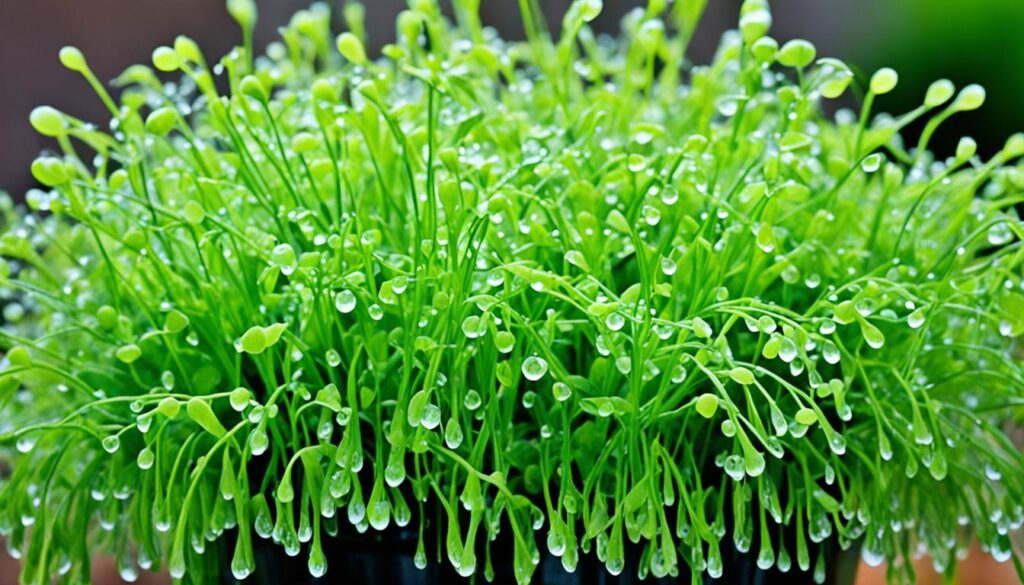
The baby tears succulent is perfect for hanging baskets or covering the ground. It’s a beautiful, easy-care choice for anyone who loves plants.
Baby’s Tears Plant Care
The baby’s tears plant, also known as Soleirolia soleirolii, is easy to grow indoors. It does well in many lighting conditions. This indoor succulent is perfect for anyone who wants a low-care plant. It creates a lush, carpet-like look that adds beauty to any space.
Light Requirements
This plant likes bright, indirect light or partial shade. It can handle different light levels, making it great for easy houseplants in various spots. But, don’t put it in direct sunlight, as it can burn the leaves.
Soil and Potting Mix
Baby’s tears plants do well in soil that drains well and is rich in nutrients. Make sure the soil isn’t too dense, as this can cause root rot. A soil that lets air in and drains excess water is key for these plants.
Watering Needs
These plants need consistent moisture but shouldn’t sit in water. Keep the soil lightly damp, not soaked. If you water too much, it can rot the roots. Check the soil often and water only when the top inch or two feels dry.
Knowing what baby’s tears plants need for light, soil, and water will help you keep them thriving. This way, you can enjoy the beauty of these indoor succulents in your home.
Temperature and Humidity Preferences
Baby’s tears plants grow best in temperatures between 50-70°F. They can handle a bit of frost but not freezing temperatures. If you live in a cold area, keep them in pots and move them inside when it gets cold.
These plants love high humidity, around 75% or more. In warmer months, they do well with humidity between 45-55%. It’s smart to use a hygrometer to keep the humidity just right.
- Daily misting can help with humidity, but it’s not a permanent fix.
- Putting plants close together and using water trays can also increase humidity.
- Ventilation, humidifiers, and dehumidifiers can help manage humidity levels.
Creating the right temperature and humidity is crucial for your baby’s tears plant. Keeping these conditions ideal ensures your plant stays healthy and happy.
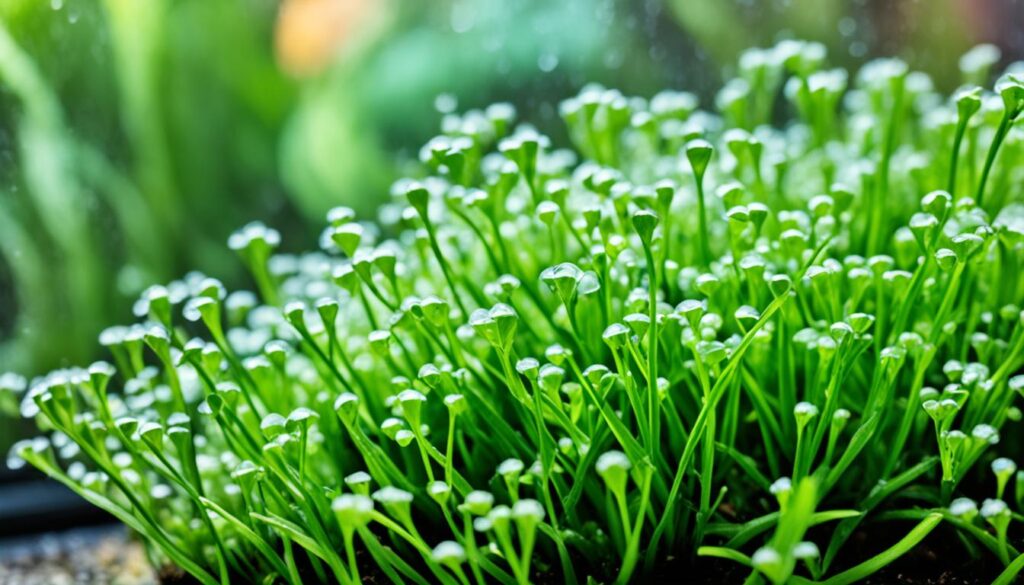
“Proper temperature and humidity are essential for the well-being of baby’s tears plants. Striking the right balance is the key to their success.”
Fertilizing Baby’s Tears Plants
To keep your Baby’s Tears plants looking great, use a balanced plant fertilizer every two weeks in spring and summer. Liquid fertilizer is best because it’s easy to apply, even when the soil is hidden.
The best balanced fertilizer mix for these plants is 10-10-10 NPK. This mix gives them the nutrients they need to grow well. You should fertilize more often when they’re growing fast, like every 4-6 weeks. But, cut back to every 8-12 weeks in fall and winter when they grow slower.
- Liquid fertilizers work fast and are perfect for Baby’s Tears plants.
- Organic fertilizers feed plants slowly, helping them grow steadily and keeping soil healthy.
- Don’t over-fertilize, as it can cause problems like yellow leaves, brown tips, and wilting.
If you over-fertilize, remove any visible fertilizer and flush out the excess with water. Trim any damaged leaves. If it’s really bad, you might need to repot the plant with fresh soil.
“Proper fertilization is key to maintaining the lush, vibrant appearance of Baby’s Tears plants in the home.”
By using a balanced plant fertilizer routine, your Baby’s Tears plants will flourish. They’ll keep making your home look beautiful.
Baby’s Tears Plant Varieties
The Soleirolia soleirolii, also known as Baby’s Tears plant, has many exciting types. They range from the golden leaves of soleirolia soleirolii ‘Aurea’ to the yellow edges of soleirolia soleirolii ‘Golden Queen’. This plant has something special for every gardener.
If you like a silvery look, soleirolia soleirolii ‘Silver Queen’ has beautiful silver-gray leaves. Soleirolia soleirolii ‘Variegata’ shows off leaves with white spots. These options let gardeners match their plants to their style.
- Soleirolia soleirolii ‘Aurea’ – Features golden leaves that are shorter than others
- Soleirolia soleirolii ‘Golden Queen’ – Has yellow edges on its leaves
- Soleirolia soleirolii ‘Silver Queen’ – Shows off stunning silver-gray leaves
- Soleirolia soleirolii ‘Variegata’ – Displays leaves with silvery patterns and white spots
Every Baby’s Tears plant is a beautiful, easy-care addition to any spot. They’re perfect for gardeners who want a bit of green magic.
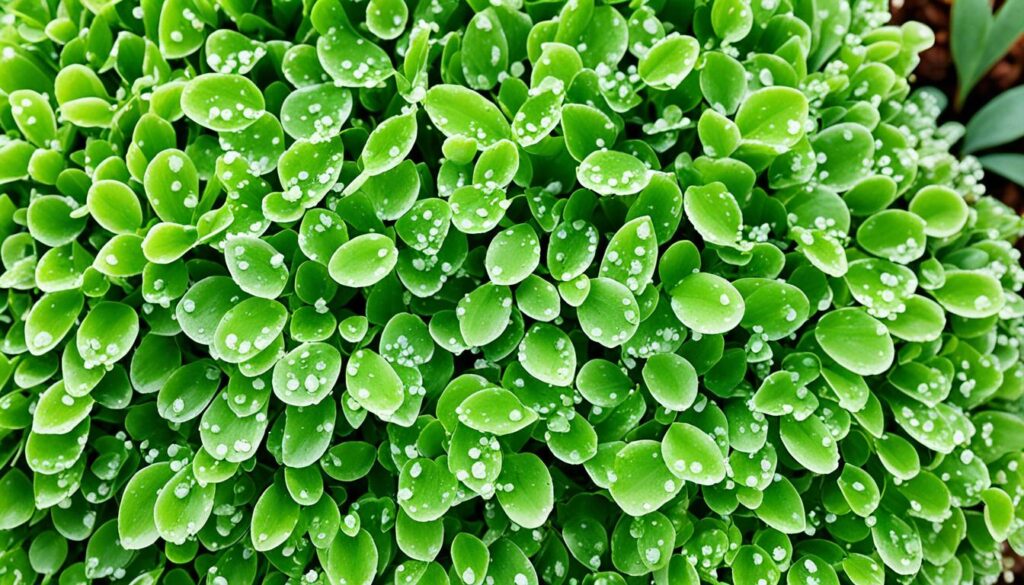
Pruning and Grooming
Regular pruning and trimming of baby’s tears plants can keep them looking great. It also encourages new growth and stops them from taking over other plants in containers or terrariums. Pruning is key when growing them as companion plants or in tight spaces.
Trimming and Shaping
To keep your baby’s tears plant looking great, gently trim and shape the leaves as needed. Use sharp scissors or pruning shears for this. Remove any dead, damaged, or long leaves and stems to keep it neat and compact.
- Don’t cut off too much foliage at once to avoid stressing the plant.
- Trim the plant every few weeks when it’s growing to keep it tidy.
- Don’t prune during the winter when the plant is asleep.
“Regular pruning and trimming can greatly improve a baby’s tears plant’s health and look. This is especially true when grown with companion plants or in terrariums.”
Propagating Baby’s Tears Plants
The Baby’s Tears plant is easy to spread. You can grow more or share it with others easily. Propagating it is simple. You can use division or stem cuttings to make new plants.
Division
Division is a simple way to spread Baby’s Tears. Just take a part of the plant with roots and put it in fresh soil. This way, the new part will grow roots fast, usually in a few weeks.
Stem Cuttings
Stem cuttings are another great way to spread Baby’s Tears. Cut 2-inch stem cuttings and remove the lower leaves. Plant them in moist soil. You can use rooting hormone to help them grow roots faster. In about 3-4 weeks, you’ll see roots and new growth.
Choosing the right time to propagate is important. Spring and summer are best for Baby’s Tears. The warm weather and lots of light help new plants grow well. By using these easy methods, you can grow more Baby’s Tears and share it with others.
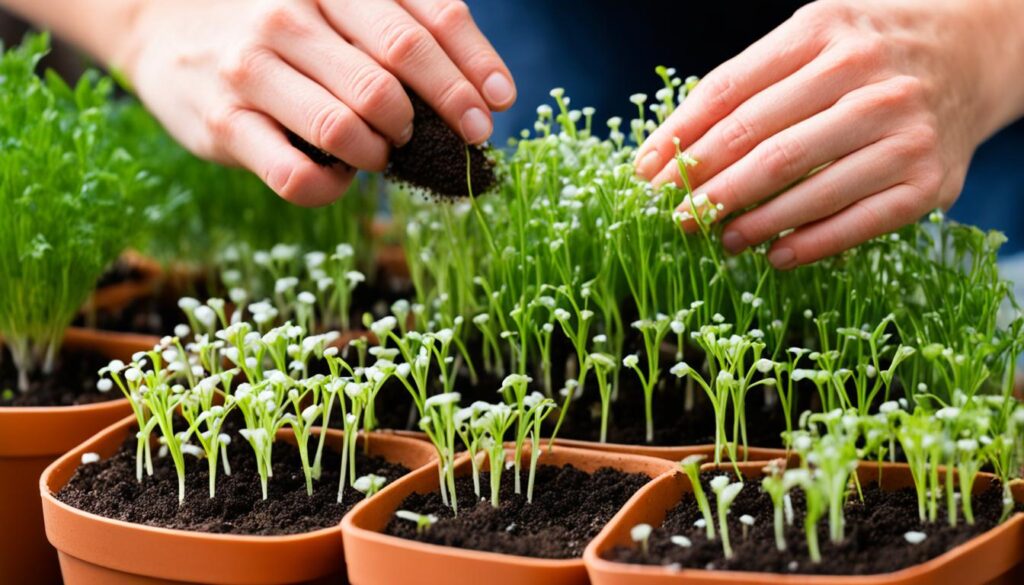
Container Gardening with Baby’s Tears
Baby’s tears plants are perfect for container gardening. They do well in hanging baskets, terrariums, or pots. These plants grow fast, so you’ll need to repot them often to keep them healthy.
Repotting and Container Selection
When it’s time to move your baby’s tears plant, pick a container that’s a bit bigger than the old one. This lets the roots grow well. Carefully take the plant out of its pot without pulling the stems. Then, put it into a new container filled with good potting mix for container gardens. Water it well after moving to help it settle.
Since baby’s tears grow quickly, you’ll need to repot them every 1-2 years. The right container and potting mix help them thrive in their space.
“Baby’s tears plants are the perfect choice for adding a lush, carpet-like texture to your indoor or outdoor containers.”
Whether in hanging baskets, terrariums, or pots, repotting and good potting mix keep baby’s tears plants looking great. With proper care, these plants add beauty to any container garden.
Overwintering Baby’s Tears Plants
When the weather gets colder and frost comes, you need to take good care of your baby’s tears plants. These plants can’t handle the cold and freezing temperatures. If you live where winters are harsh, put your baby’s tears in pots and bring them inside before the first frost.
When you move your baby’s tears inside for the winter, they might lose some leaves. But, they will get better once it’s warmer. The best temperature for these plants is between 55-75°F (12-24°C). They also need humidity of 40-60%.
For a healthy winter, put your baby’s tears in a bright spot, like a south-facing window. But, don’t put them in direct sunlight because it can burn their leaves. Keep the soil a bit damp, but don’t soak it, or the roots might rot.
Use misting or a pebble tray to keep the humidity right for your plant. You might also want a small humidifier near it to keep the air moist. This helps prevent the leaves from drying out.
Follow these tips to make sure your baby’s tears plant makes it through the winter. It will be ready to bloom again in spring.
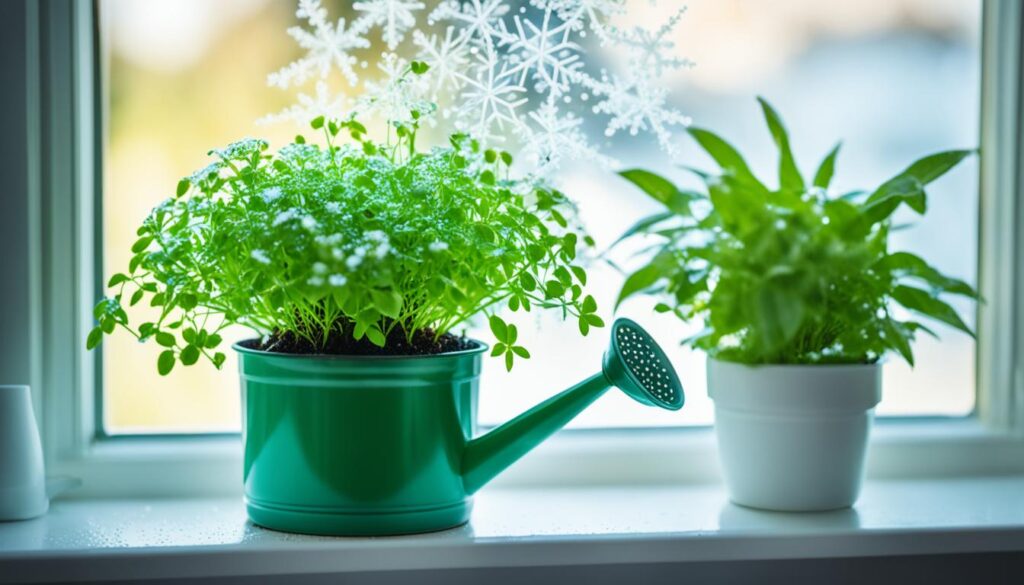
“Baby’s tears plants are delicate and require special care during the winter months to ensure their survival.”
Pests and Diseases
Baby’s tears plants are usually easy to care for but can face pests and diseases if not watched over. Pests like aphids, mites, mealybugs, and diseases like root rot can harm them. Knowing how to deal with these issues is key to keeping your plant healthy.
Tackling Pests
Spider mites are a common pest for baby’s tears plants. They leave behind webs and harm the leaves. To fight them, use neem oil or insecticidal soap.
Scale insects look like bumps on the plant and take nutrients away. Rubbing alcohol on cotton pads can get rid of them.
Fungus gnats and fruit flies live in the soil, causing problems. Use hydrogen peroxide in the soil and sticky traps to control them.
Mealybugs form cottony clusters, and whiteflies fly around the plant. Neem oil works well against both.
Addressing Diseases
Baby’s tears plants can get diseases too. Bacterial leaf spot shows as yellow marks and often means watering issues.
Root rot happens when the soil stays too wet. Make sure the soil drains well to prevent this.
Powdery mildew, a fungal disease, looks like a dusty coating on leaves. Use neem oil and improve air flow to fight it.
By watching for pests and diseases and acting fast, you can keep your baby’s tears plant healthy and happy for a long time.
Flowering and Blooming
Baby’s tears plants, known as Soleirolia soleirolii, are loved for their delicate leaves. They can also produce tiny, fragrant flowers. When grown outside in the right conditions, they bloom with creamy white flowers in late spring to early summer.
But, indoor baby’s tears plants don’t often flower. To see more blooms, plant them as groundcover or edging in a spot that gets some sun and has lots of moisture. The flowers give off a sweet fragrance, making the garden even more charming.
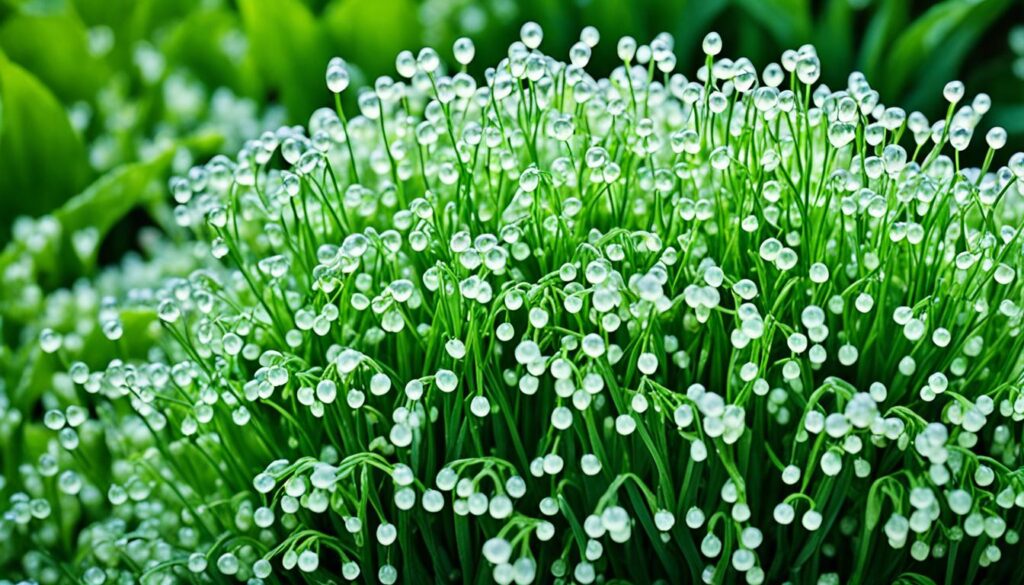
“The best chance for abundant flowering is to plant baby’s tears as an outdoor groundcover or edging plant in partial sun with ample moisture.”
The flowers are a nice bonus, but the real beauty of baby’s tears is its lush, verdant blooms. These blooms create a dense, carpet-like effect in the garden. With the right care and conditions, gardeners can enjoy this unique plant all year round.
Conclusion
Baby’s tears plants are easy-to-grow and perfect for both indoor and outdoor gardens. They need consistent moisture and high humidity. With the right light and soil, these resilient plants can do well and spread out.
These plants are great for anyone, whether you’re experienced or new to gardening. They add a lush, whimsical touch to any space. By creating the right environment, you can enjoy their beauty and charm.
Baby’s tears plants are great for those with little time or new to gardening. They can handle different light levels and are easy to care for. By following the advice in this article, you can have these lovely plants for many years.
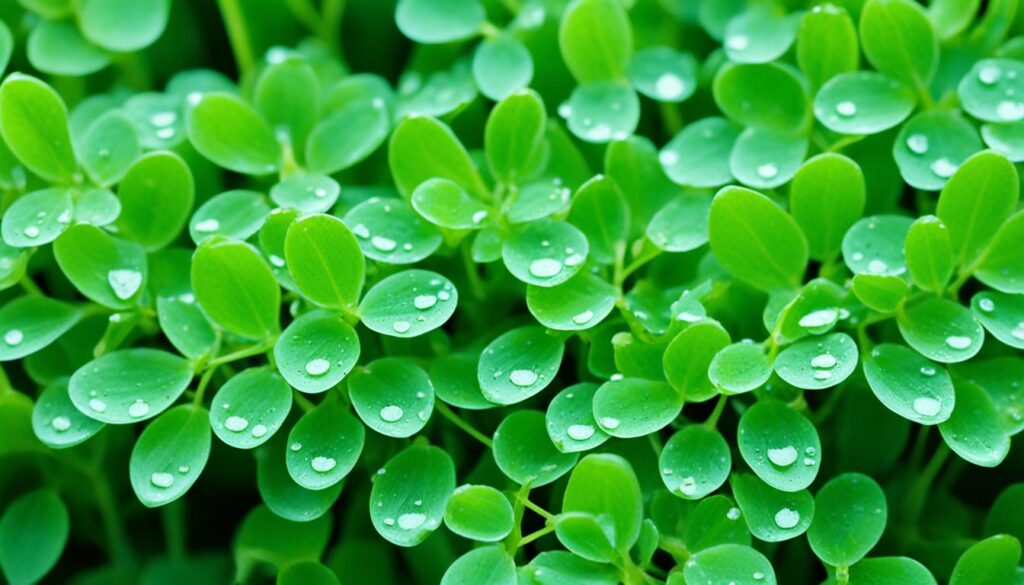


I don’t think the title of your article matches the content lol. Just kidding, mainly because I had some doubts after reading the article.